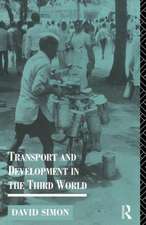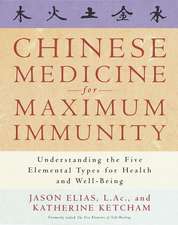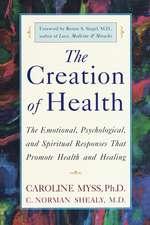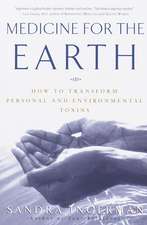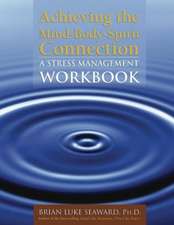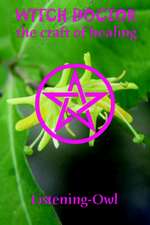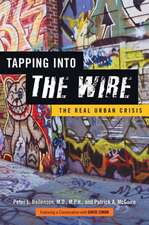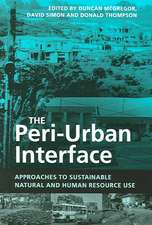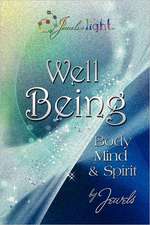The Wisdom of Healing: A Natural Mind Body Program for Optimal Wellness
Autor M. D. Simon, David Simon, Deepak Chopraen Limba Engleză Paperback – 31 iul 1998
In these pages you will also learn how to use food as medicine; relaxation techniques; healing breath and neuromuscular exercises; techniques for detoxification, purification, and rejuvenation; and strategies for addressing such specific conditions as reproduction and pregnancy, aging, diabetes, heart disease, cancer, and chronic pain. Intermingled with medical advice is the story of the author's journey as a young medical student, his disappointment with the traditional emphasis on the mechanics of disease and diagnosis, and his discovery of a medical science that focuses on the patient in its strategies for achieving and maintaining optimal health. By integrating this book's information into your life you will become as nature intended--restored to optimal health in body, mind, and spirit, free to experience the joy in every moment.
Preț: 121.68 lei
Nou
Puncte Express: 183
Preț estimativ în valută:
23.28€ • 24.90$ • 19.41£
23.28€ • 24.90$ • 19.41£
Carte disponibilă
Livrare economică 27 martie-10 aprilie
Preluare comenzi: 021 569.72.76
Specificații
ISBN-13: 9780609802144
ISBN-10: 0609802143
Pagini: 384
Dimensiuni: 156 x 233 x 26 mm
Greutate: 0.56 kg
Editura: HARMONY
ISBN-10: 0609802143
Pagini: 384
Dimensiuni: 156 x 233 x 26 mm
Greutate: 0.56 kg
Editura: HARMONY
Notă biografică
After graduating medical school at the University of Chicago, David Simon received training in internal medicine and neurology. He moved to San Diego, serving as medical director for neurological services at Sharp Cabrillo Hospital and as chief of the medical staff. Today Dr. Simon is medical director of The Chopra Center for Well Being in La Jolla, California.
Extras
Creating a Universe:
"Each thing we see hides something else we want to see."
--René Magritte
"The world is moving too fast," lamented the successful middle-aged stock broker. He had worked hard to achieve his senior status and his top floor view office, but now complained, "I just don't feel I can keep up with all the changes that are happening." He was having trouble sleeping and getting a migraine headache almost daily. Although they were annoying during the week, they became almost explosive on Saturday mornings requiring him to stay in bed a good part of each weekend. He gained partial relief by drinking coffee-- consuming almost six cups each day. Although his house was paid for, his pension fully funded and his children's college funds well stocked, he hadn't taken a real vacation in over four years.
From a Western perspective, this man was having caffeine-withdrawal headaches, exacerbated by his irregular sleep-wake pattern. From the Ayurvedic point-of-view this poor man's life was being ruled by movement without rhythm. The air element (Vayu) had become excessive and was carrying him away. He needed to come back down to earth (Prithivi) , and recapture his steadiness, stability and balance that had always been his character. He needed to remember what he was really made of and return to his true nature.
In every culture throughout history, human beings have speculated as to how the world began, and about the principles that continue to structure and govern it. Our fundamental human interest in the beginning is not just of a metaphysical nature. There has always been a sense that, by thinking about how things began, we can understand the powers that are still at work in our daily experience of the world. In the ancient world these cosmic speculations were generally quite poetic and metaphorical. A Chinese creation myth, for instance, describes the universe as originating from a gigantic hen's egg, while a Norse myth refers to a primordial cow emerging from a block of ice. Both these stories imply that animals are vehicles through which supreme powers express themselves, and this veneration of animals manifested itself elsewhere in art, religion, and even in early medicine. The Judeo-Christian tradition describes the beginnings of the universe in more abstract terms, with the disembodied voice of God commanding, "Let there be light."
Anthropologists debate the extent to which the peoples of the past thought that their myths literally described the process of creation. In the case of the Scandinavian peoples and their story of the "ice cow," for example, its clear that the myth was of primarily symbolic significance, and that its importance was in the psychological and perhaps subconscious connotations evoked by the narrative, rather than as a depiction how the universe really began. But now, at the end of the twentieth century, there is no doubt that cosmologists believe the current scientific model of creation is intended to describe "what really happened." According to the so-called Big Bang theory, the universe began when an entity of incomprehensible density exploded, generating the matter which comprises the galaxies and propelling it outward at unimaginable speeds. Over time, primordial matter cooled and condensed resulting in galaxies, stars and planets. Most cosmologists believe that the universe will continue to expand, doubling its known size over the next ten billion years. Will gravitational forces eventually overcome the expansion of the universe leading to a contraction back to the center? This concept of an oscillating universe that expands and contracts over eons of time evokes the Vedic image of a breathing cosmos--the exhaling and inhaling of Brahman, the primordial creator. Modern cosmologists continue to debate the ultimate fate of our universe.
Despite some dissenters, the Big Bang theory is the prevailing explanation of the origin of the cosmos. But although it seems to fairly accurately describe the universe as we perceive it, the theory raises the question of what preceded the cosmic explosion? Where did the original entity come from? How long did it exist before exploding? What caused it to suddenly break apart?
Scientists respond to these inquiries in various ways. To the physicist Steven Hawking, such questions are very understandable but scientifically naive. Asking what came before the Big Bang, he has said, is like asking what's north of the North Pole. And yet, great scientists, including Albert Einstein, have not so readily dismissed these questions as they searched for a unified theory that would define the essential "stuff" our of which the universe arose.
Ayurveda teaches that consciousness is, in effect, the unifying principle that physicists are seeking. Consciousness is the organizing essence of the universe which simultaneously transcends and creates the world we perceive. The essential "stuff" of the universe is actually non-stuff. But this essential "non-stuff" is not the same as emptiness, for within it is contained the potential for all that was, is and will be. The seen world has its roots in the unseen field of pure potentiality -- in consciousness. From this primal consciousness, the elements that make up the universe come into being. Western science has not yet named this unifying essence and might be reluctant to embrace the terms consciousness or pure potentiality. Yet, when we look at the original Ayurvedic term for this primordial state from which the universe arose, the Sanskrit word, Avyakta, simply means "Unmanifest." Contained within the Unmanifest is the impulse to create, known in Ayurveda as Prakruti or nature. In essence, Ayurveda simply describes the universe as arising from a field of potentiality that has an intrinsic nature to create.
Modern physics also describes the universe -- consisting of time, space and matter -- as arising from a timeless, spaceless point. This is the culmination of a long tradition in Western thought. Pre-Socratic philosophers such as Heraclitus asserted the existence of a basic substance from which all things came and to which all things returned. Heraclitus called this primordial essence logos, which is the root word of logic and intelligence. The logos of Heraclitus can be understood as a cosmic governing and generating principle analogous to the primordial Consciousness of Ayurveda, and here the Western and Eastern traditions begin to sound very much alike.
The Ayurvedic concept of creation describes not only the beginning of the universe, but a continuing creative process which is occurring at every moment. Ayurveda teaches that the entire universe unfolds through the interaction of three vital principles, which in Sanskrit are known as the Gunas. They are Sattva, the creative principle; Rajas, the principle of maintenance; and Tamas, the principle of destruction. Everything that we perceive through our senses, from elementary particles to galaxies, is born, has a life span, and eventually dies. In this dynamic cycles, the Gunas are the principles that are continuously expressing themselves.
According to Vedic philosophy, the three Gunas interact to create both subjective and objective realities. In the subjective realm, the five sense organs, five motor organs, and the conscious mind are brought into being. On the objective side, the Gunas give rise to five great elements, or Mahabhutas and five subtle elements, or Tanmatras, the quanta of perceptual experience that feed our five sense organs. The five great elements are the codes of nature that compose the world of perceived forms.
The Vedic sages derived their insights into the nature of reality without benefit of sophisticated scientific instruments. They simply looked inside themselves, and discovered the secrets of the universe within their own physical beings and their consciousness. Their understanding of the world in terms of five great elements is at once simple and profound. Though this perspective is of ancient origin, the concepts are relevant to our current understanding of reality, and can even illuminate our understanding of Western scientific principles. We can, for example, describe chemical reactions as the application of the fire principle, or energy, to systems composed of the earth element, or atoms. This increases the movement principle (the wind element) of the atoms, causing a reorganization of bonds (the water element), which results in a new substance.
Similarly, in nuclear reactions a powerful acceleration of the movement principle (the wind element) within a system overcomes strong intranuclear bonding (the water element), liberating tremendous amounts of energy (fire) as subatomic particles are released from their bondage.
The theory of the five elements can be applied to human social systems as well. The fast paced lives we live in the West, which are expressions of the wind principle, are disruptive to the social cohesion (water) that bonds members of families, communities, or other organizations that are expressions of the earth principle. The absence of a unifying social fabric results in chaotic releases of emotional energy (fire) that are the bases of the unprecedented levels of violence in our society today.
By beginning to think of the world in terms of space, wind, fire, water, and earth, we can gain insight into how the field of pure Unmanifest consciousness interacts with itself to create manifest reality. This process is nothing other than the miracle of creation.
Vedic science teaches that we create our own reality. Consciousness, the field of all possibilities, systematically consolidates itself into the material world. The same field of intelligence that structures the galaxies, planets, mountains and atoms, creates living beings. The same intelligence that organizes the solar system, the seasons, and even the migration of birds is the origin of the creative thoughts that arise in our minds. This understanding is eloquently expressed in a Vedic poem:
As is the individual, so is the universe.
As is the human body, so is the cosmic body.
As is the human mind, is the cosmic mind.
As is the microcosm, so is the macrocosm.
"Each thing we see hides something else we want to see."
--René Magritte
"The world is moving too fast," lamented the successful middle-aged stock broker. He had worked hard to achieve his senior status and his top floor view office, but now complained, "I just don't feel I can keep up with all the changes that are happening." He was having trouble sleeping and getting a migraine headache almost daily. Although they were annoying during the week, they became almost explosive on Saturday mornings requiring him to stay in bed a good part of each weekend. He gained partial relief by drinking coffee-- consuming almost six cups each day. Although his house was paid for, his pension fully funded and his children's college funds well stocked, he hadn't taken a real vacation in over four years.
From a Western perspective, this man was having caffeine-withdrawal headaches, exacerbated by his irregular sleep-wake pattern. From the Ayurvedic point-of-view this poor man's life was being ruled by movement without rhythm. The air element (Vayu) had become excessive and was carrying him away. He needed to come back down to earth (Prithivi) , and recapture his steadiness, stability and balance that had always been his character. He needed to remember what he was really made of and return to his true nature.
In every culture throughout history, human beings have speculated as to how the world began, and about the principles that continue to structure and govern it. Our fundamental human interest in the beginning is not just of a metaphysical nature. There has always been a sense that, by thinking about how things began, we can understand the powers that are still at work in our daily experience of the world. In the ancient world these cosmic speculations were generally quite poetic and metaphorical. A Chinese creation myth, for instance, describes the universe as originating from a gigantic hen's egg, while a Norse myth refers to a primordial cow emerging from a block of ice. Both these stories imply that animals are vehicles through which supreme powers express themselves, and this veneration of animals manifested itself elsewhere in art, religion, and even in early medicine. The Judeo-Christian tradition describes the beginnings of the universe in more abstract terms, with the disembodied voice of God commanding, "Let there be light."
Anthropologists debate the extent to which the peoples of the past thought that their myths literally described the process of creation. In the case of the Scandinavian peoples and their story of the "ice cow," for example, its clear that the myth was of primarily symbolic significance, and that its importance was in the psychological and perhaps subconscious connotations evoked by the narrative, rather than as a depiction how the universe really began. But now, at the end of the twentieth century, there is no doubt that cosmologists believe the current scientific model of creation is intended to describe "what really happened." According to the so-called Big Bang theory, the universe began when an entity of incomprehensible density exploded, generating the matter which comprises the galaxies and propelling it outward at unimaginable speeds. Over time, primordial matter cooled and condensed resulting in galaxies, stars and planets. Most cosmologists believe that the universe will continue to expand, doubling its known size over the next ten billion years. Will gravitational forces eventually overcome the expansion of the universe leading to a contraction back to the center? This concept of an oscillating universe that expands and contracts over eons of time evokes the Vedic image of a breathing cosmos--the exhaling and inhaling of Brahman, the primordial creator. Modern cosmologists continue to debate the ultimate fate of our universe.
Despite some dissenters, the Big Bang theory is the prevailing explanation of the origin of the cosmos. But although it seems to fairly accurately describe the universe as we perceive it, the theory raises the question of what preceded the cosmic explosion? Where did the original entity come from? How long did it exist before exploding? What caused it to suddenly break apart?
Scientists respond to these inquiries in various ways. To the physicist Steven Hawking, such questions are very understandable but scientifically naive. Asking what came before the Big Bang, he has said, is like asking what's north of the North Pole. And yet, great scientists, including Albert Einstein, have not so readily dismissed these questions as they searched for a unified theory that would define the essential "stuff" our of which the universe arose.
Ayurveda teaches that consciousness is, in effect, the unifying principle that physicists are seeking. Consciousness is the organizing essence of the universe which simultaneously transcends and creates the world we perceive. The essential "stuff" of the universe is actually non-stuff. But this essential "non-stuff" is not the same as emptiness, for within it is contained the potential for all that was, is and will be. The seen world has its roots in the unseen field of pure potentiality -- in consciousness. From this primal consciousness, the elements that make up the universe come into being. Western science has not yet named this unifying essence and might be reluctant to embrace the terms consciousness or pure potentiality. Yet, when we look at the original Ayurvedic term for this primordial state from which the universe arose, the Sanskrit word, Avyakta, simply means "Unmanifest." Contained within the Unmanifest is the impulse to create, known in Ayurveda as Prakruti or nature. In essence, Ayurveda simply describes the universe as arising from a field of potentiality that has an intrinsic nature to create.
Modern physics also describes the universe -- consisting of time, space and matter -- as arising from a timeless, spaceless point. This is the culmination of a long tradition in Western thought. Pre-Socratic philosophers such as Heraclitus asserted the existence of a basic substance from which all things came and to which all things returned. Heraclitus called this primordial essence logos, which is the root word of logic and intelligence. The logos of Heraclitus can be understood as a cosmic governing and generating principle analogous to the primordial Consciousness of Ayurveda, and here the Western and Eastern traditions begin to sound very much alike.
The Ayurvedic concept of creation describes not only the beginning of the universe, but a continuing creative process which is occurring at every moment. Ayurveda teaches that the entire universe unfolds through the interaction of three vital principles, which in Sanskrit are known as the Gunas. They are Sattva, the creative principle; Rajas, the principle of maintenance; and Tamas, the principle of destruction. Everything that we perceive through our senses, from elementary particles to galaxies, is born, has a life span, and eventually dies. In this dynamic cycles, the Gunas are the principles that are continuously expressing themselves.
According to Vedic philosophy, the three Gunas interact to create both subjective and objective realities. In the subjective realm, the five sense organs, five motor organs, and the conscious mind are brought into being. On the objective side, the Gunas give rise to five great elements, or Mahabhutas and five subtle elements, or Tanmatras, the quanta of perceptual experience that feed our five sense organs. The five great elements are the codes of nature that compose the world of perceived forms.
The Vedic sages derived their insights into the nature of reality without benefit of sophisticated scientific instruments. They simply looked inside themselves, and discovered the secrets of the universe within their own physical beings and their consciousness. Their understanding of the world in terms of five great elements is at once simple and profound. Though this perspective is of ancient origin, the concepts are relevant to our current understanding of reality, and can even illuminate our understanding of Western scientific principles. We can, for example, describe chemical reactions as the application of the fire principle, or energy, to systems composed of the earth element, or atoms. This increases the movement principle (the wind element) of the atoms, causing a reorganization of bonds (the water element), which results in a new substance.
Similarly, in nuclear reactions a powerful acceleration of the movement principle (the wind element) within a system overcomes strong intranuclear bonding (the water element), liberating tremendous amounts of energy (fire) as subatomic particles are released from their bondage.
The theory of the five elements can be applied to human social systems as well. The fast paced lives we live in the West, which are expressions of the wind principle, are disruptive to the social cohesion (water) that bonds members of families, communities, or other organizations that are expressions of the earth principle. The absence of a unifying social fabric results in chaotic releases of emotional energy (fire) that are the bases of the unprecedented levels of violence in our society today.
By beginning to think of the world in terms of space, wind, fire, water, and earth, we can gain insight into how the field of pure Unmanifest consciousness interacts with itself to create manifest reality. This process is nothing other than the miracle of creation.
Vedic science teaches that we create our own reality. Consciousness, the field of all possibilities, systematically consolidates itself into the material world. The same field of intelligence that structures the galaxies, planets, mountains and atoms, creates living beings. The same intelligence that organizes the solar system, the seasons, and even the migration of birds is the origin of the creative thoughts that arise in our minds. This understanding is eloquently expressed in a Vedic poem:
As is the individual, so is the universe.
As is the human body, so is the cosmic body.
As is the human mind, is the cosmic mind.
As is the microcosm, so is the macrocosm.
Descriere
Dr. Simon, an internationally recognized expert on mind-body medicine and medical director of The Chopra Center for Well Being, reveals in more depth than ever before the philosophy and benefits of Ayurvedic medicine, with an emphasis on specific ailments and treatments.

